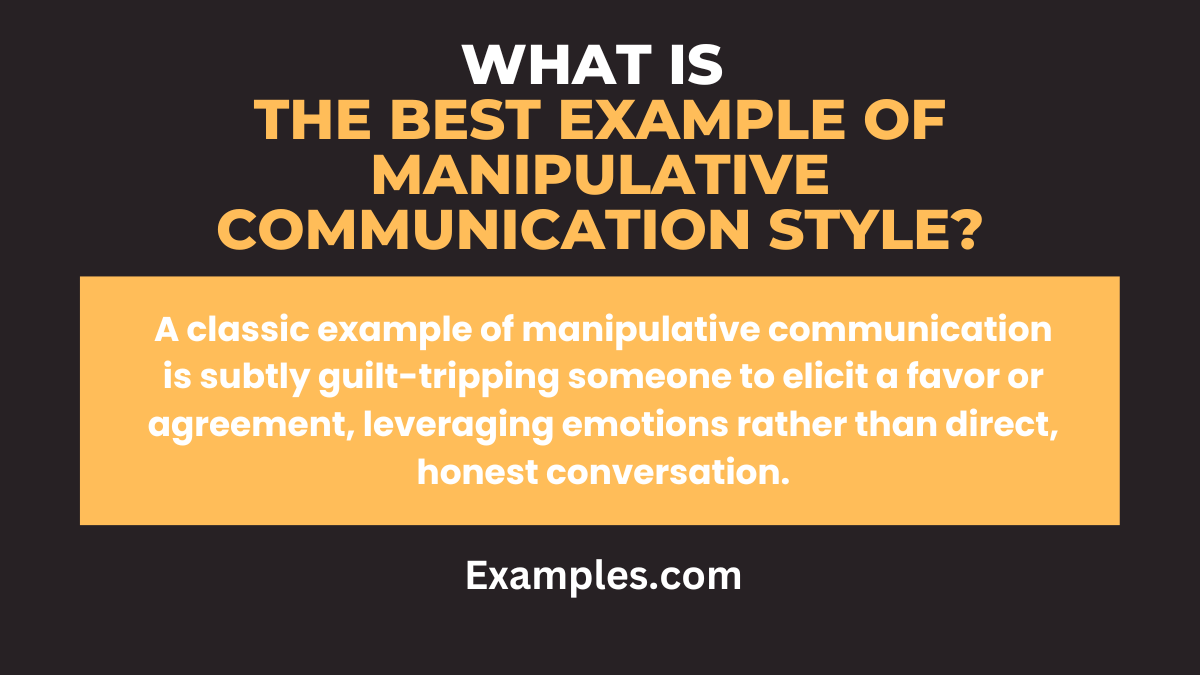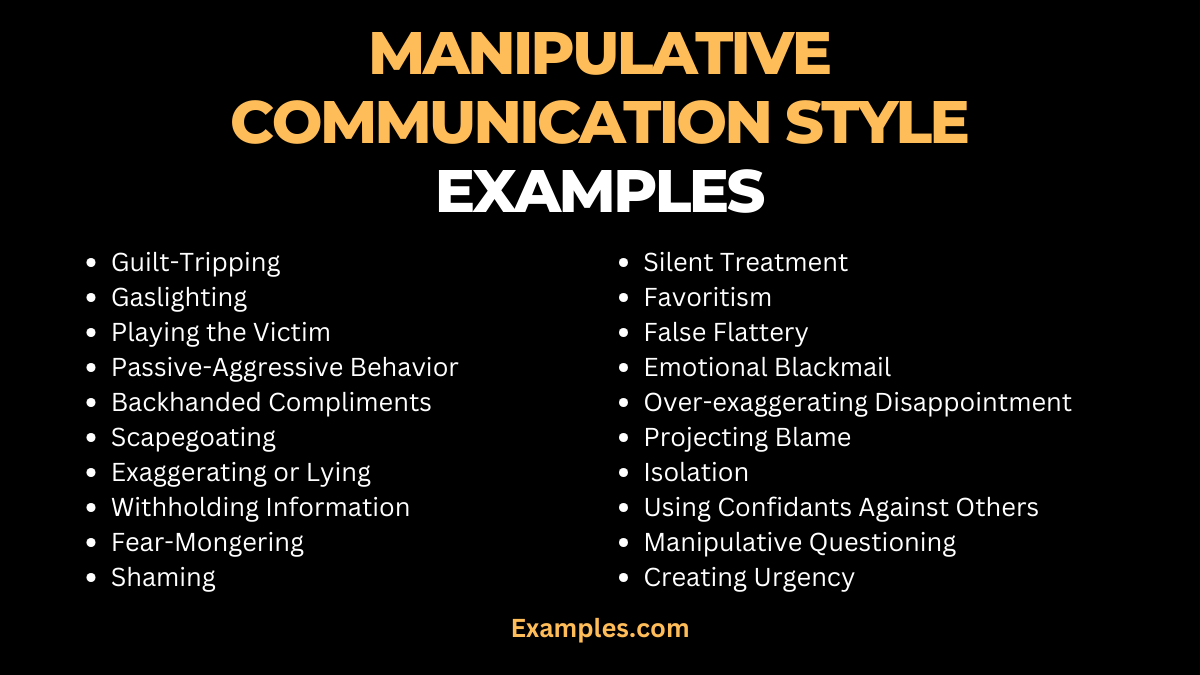19+ Manipulative Communication Style Examples
Manipulative communication style, a complex facet of human communication, often involves subtle tactics to influence or control others. This guide delves into the nuances of this communication approach, providing insightful communication examples to illustrate its application in various contexts. From personal relationships to workplace communication, understanding manipulative behaviors is crucial for recognizing and addressing them effectively. Whether in leadership roles or everyday interactions, this guide offers a comprehensive look into the intricacies of manipulative communication and its impact.
Download Manipulative Communication Style in PDFWhat is Manipulative Communication Style?

Manipulative communication style refers to a way of interacting where a person tries to influence or control others’ thoughts or actions in a subtle or deceptive manner. It often involves using emotional cues, misleading information, or indirect tactics to achieve a desired outcome without directly stating intentions. This style can be seen in various contexts, from personal relationships to the workplace, and is characterized by a lack of direct and honest communication. Manipulative communicators typically prioritize their own needs or goals at the expense of others’.
What is the Best Example of Manipulative Communication Style?

A prominent example of manipulative communication style is guilt-tripping, often used in both personal and professional contexts. This tactic involves making someone feel guilty to sway their decisions, typically through subtle emotional manipulation. For instance, a statement like, “I always help you, why can’t you do this for me?” leverages feelings of indebtedness, impacting dynamics significantly, as seen in various Communication Styles in Relationships or Communication Styles in the Workplace.
20 Manipulative Communication Style Examples

Manipulative communication is a subtle yet impactful style, often found in various interpersonal dynamics. It involves strategies that subtly influence or control others’ actions or perceptions, frequently used in both personal and professional environments. These tactics can range from guilt-tripping to gaslighting, often leaving the recipient feeling confused or coerced. Understanding these manipulative techniques is crucial for recognizing and countering them effectively. Here are ten examples of manipulative communication styles, each explained with an example sentence to illustrate how these tactics manifest in real-life interactions.
- Guilt-Tripping: Inducing guilt to influence others.
- Example: “After all I’ve done for you, you’re refusing to help me with this one thing.”
- Gaslighting: Making someone doubt their reality or perceptions.
- Example: “You’re being overly sensitive. That’s not at all how it happened.”
- Playing the Victim: Portraying oneself as the victim to gain sympathy or avoid responsibility.
- Example: “I always have the worst luck and nobody wants to help me.”
- Passive-Aggressive Behavior: Expressing negative feelings indirectly instead of openly addressing them.
- Example: “Fine, go out with your friends. I’ll just stay home alone, as usual.”
- Backhanded Compliments: Seemingly positive comments that contain a critical undertone.
- Example: “You did well on the project, surprisingly.”
- Scapegoating: Blaming others unfairly to deflect responsibility.
- Example: “Our team failed because you didn’t work hard enough.”
- Exaggerating or Lying: Distorting the truth to manipulate a situation.
- Example: “Everyone agrees with me that your idea won’t work.”
- Withholding Information: Deliberately keeping important information to maintain control.
- Example: “I didn’t think you needed to know about that meeting.”
- Fear-Mongering: Using fear to influence others’ actions or decisions.
- Example: “If you don’t do this, you might lose your job.”
- Shaming: Using shame to control or belittle someone.
- Example: “You should be embarrassed for making such a mistake.”
- Silent Treatment: Using silence as a tool to punish or coerce.
- Example: “I won’t talk to you until you apologize.”
- Favoritism: Giving preferential treatment to manipulate others.
- Example: “I always give the best tasks to those who agree with me.”
- False Flattery: Using insincere praise to get what one wants.
- Example: “You’re the only one smart enough to handle this task for me.”
- Emotional Blackmail: Threatening to hurt oneself or others emotionally to gain compliance.
- Example: “If you leave, I’ll be devastated and it’ll be your fault.”
- Over-exaggerating Disappointment: Exaggerating sadness to make others feel guilty.
- Example: “You’ve let me down immensely by not attending my event.”
- Projecting Blame: Redirecting blame onto others unfairly.
- Example: “It’s your fault that we’re in this situation.”
- Isolation: Trying to distance someone from their support system.
- Example: “Your friends don’t really understand you like I do.”
- Using Confidants Against Others: Sharing secrets or confidential information to create alliances.
- Example: “I heard from John that he doesn’t trust your judgment.”
- Manipulative Questioning: Asking leading or loaded questions to trap the other person.
- Example: “Don’t you care about our team’s success at all?”
- Creating Urgency: Making a situation seem more urgent than it is to rush a decision.
- Example: “If you don’t decide right now, you’ll miss out completely.”
Manipulative Communication Style in the Workplace
Manipulative communication in the workplace can subtly undermine team dynamics and individual well-being. It often manifests through tactics that skew perceptions or coerce colleagues, impacting the overall work environment. Understanding these behaviors is key to fostering a healthier, more transparent workplace culture. Here are ten examples, each illustrating how manipulative communication can occur in professional settings:
- Assigning Unreasonable Deadlines: Pressuring employees with unrealistic timeframes.
- Example: “I need this complex project done by tomorrow, no excuses.”
- Taking Credit for Others’ Work: Claiming others’ achievements as one’s own.
- Example: “The success of this project was due to my leadership.”
- Spreading Rumors: Using gossip to undermine colleagues.
- Example: “I heard that our manager is not happy with your performance.”
- Selective Information Sharing: Withholding key information from certain team members.
- Example: “I didn’t think you needed to be involved in that decision.”
- Undermining Decisions: Subtly discrediting others’ ideas or decisions.
- Example: “It’s a good attempt, but I doubt it will work.”
- Excessive Flattery to Gain Favor: Over-complimenting superiors for personal gain.
- Example: “You’re the best manager ever. Your idea is definitely superior.”
- Setting Colleagues Against Each Other: Creating competition to distract or control.
- Example: “I bet you can outperform John on this project.”
- False Promises: Making commitments with no intention of keeping them.
- Example: “Help me with this, and I’ll make sure you’re rewarded.”
- Downplaying Others’ Concerns: Minimizing valid concerns to maintain control.
- Example: “I don’t think that issue is as serious as you’re making it.”
- Indirect Threats: Hinting at negative consequences to ensure compliance.
- Example: “I hope your choice doesn’t affect your career here.”
Advantages and Disadvantages of Manipulative Communication Style
Manipulative communication, a nuanced aspect of Human Communication, involves subtle tactics to influence and control others’ perceptions and actions. While it can offer strategic advantages in Leadership and crisis management, it also carries significant ethical and relational risks. Understanding this communication style is crucial in diverse settings, from personal relationships to the workplace, where the line between influence and manipulation often blurs.
Advantages
- Enhanced Persuasive Skills: Employing a manipulative communication style can lead to enhanced persuasive abilities. This skill is particularly useful in situations where influencing others is crucial, such as in sales or marketing roles.
- Effective Crisis Management: In crisis situations, manipulative communication can be effective in controlling the narrative. By steering conversations and perceptions, it helps in managing the crisis more efficiently.
- Flexibility in Strategy: This style offers flexibility in communication strategies, allowing individuals to adapt their approach based on the situation and the audience’s responses.
- Achievement of Specific Goals: When used strategically, manipulative communication can be a powerful tool for achieving specific objectives, particularly in competitive environments.
- Influence Over Group Dynamics: It allows individuals to shape and direct group dynamics in a way that favors their objectives, which can be beneficial in both personal and professional settings.
Disadvantages
- Risk of Alienation: Over-reliance on manipulation can lead to alienation from peers and colleagues, especially when the tactics are discovered.
- Stress and Anxiety: Engaging in manipulative behavior can lead to increased stress and anxiety, both for the manipulator and those being manipulated.
- Damage to Personal Integrity: Continuous use of manipulation can erode personal integrity and self-respect, leading to internal conflict and ethical dilemmas.
- Unreliable Relationships: Relationships built on manipulation are often unstable and unreliable, lacking in genuine trust and mutual respect.
- Potential for Miscommunication: Manipulative communication often involves indirect and obscure messaging, which can lead to misunderstandings and miscommunication, particularly in the workplace.
Manipulative Communication Style Pros and Cons
Manipulative communication style, while offering tactical benefits in Leadership and negotiations, often leads to ethical dilemmas and trust erosion. While it can strategically influence perceptions, the long-term consequences include damaged relationships and psychological stress, both in personal interactions and within the workplace.
Pros of Manipulative Communication Style
- Tactical Advantage: In scenarios like negotiations or power dynamics, a manipulative communication style can provide a tactical edge, allowing individuals to subtly steer outcomes in their favor.
- Control in Leadership: In Leadership roles, this style can offer a sense of control over team dynamics and decision-making, enabling leaders to subtly influence their team’s direction and actions.
- Adaptive Strategy: Manipulative communication allows for an adaptive approach, tailoring interactions based on the audience and situation to achieve desired outcomes.
- Influencing Perceptions: It enables the shaping of others’ perceptions, beneficial in roles that require a strong influence over public or team opinion.
- Achievement of Specific Objectives: When applied skillfully, manipulative communication can be effective in achieving specific, short-term objectives, particularly in competitive or high-stakes environments.
Cons of Manipulative Communication Style
- Erosion of Trust: The use of manipulation in communication can lead to a significant loss of trust. Once recognized, it can damage both personal and professional relationships.
- Ethical Concerns: Employing manipulation in communication raises serious ethical issues, as it often involves deceit and exploitation, conflicting with principles of honesty and integrity.
- Psychological Impact: This style of communication can have negative psychological impacts, creating stress and anxiety for both the manipulator and those being manipulated.
- Unstable Relationships: Relationships built on manipulation are often fragile and lacking in genuine trust and respect, leading to long-term instability.
- Risk of Miscommunication: Because manipulative communication often relies on indirect and ambiguous messages, it heightens the risk of misunderstandings and miscommunication.
Which Style of Communication is Viewed as Manipulative?
The communication style most commonly viewed as manipulative is one that employs deceit and cunning tactics to influence others and achieve desired outcomes, often at the expense of others. This style is characterized by a range of behaviors and strategies that aim to control or sway the conversation and people involved.
Cunning and Control: Manipulative communicators often exhibit cunning behavior and seek to control others subtly. They might use tactics like sulking or indirect requests to get their needs met while making others feel obliged or sorry for them (Claire Newton).
The manipulative communication style presents a complex interplay of short-term benefits and long-term drawbacks. While it offers strategic control and influence, particularly in leadership and negotiations, its ethical concerns, impact on trust, and potential for damaging relationships underscore the need for careful consideration and ethical use in both personal and workplace settings.



